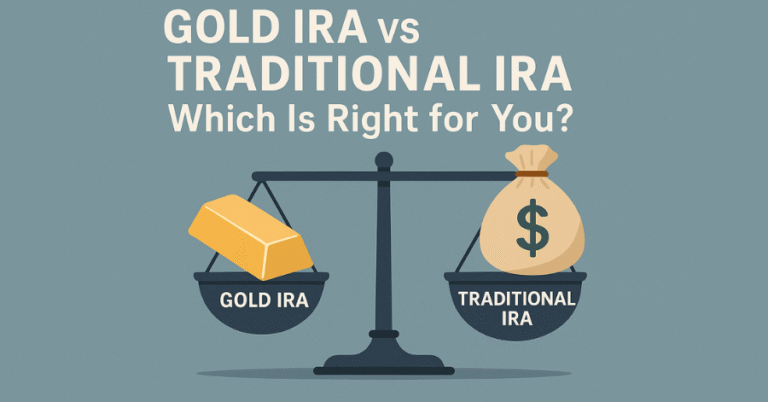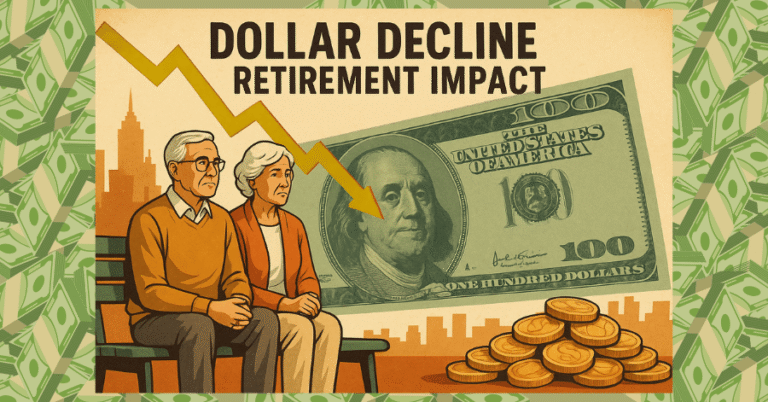Key Takeaways:
- History’s Warning on Fiat Currency: Past currency devaluations, from Weimar Germany to the 1971 “Nixon Shock,” provide a clear lesson: relying solely on a single fiat currency for long-term savings is inherently risky.
- The Threat to Purchasing Power: The most direct impact of any currency crisis is the erosion of purchasing power, meaning your savings and income buy significantly less as the value of your money declines.
- Gold as a Consistent Safe Haven: Throughout history’s most severe financial crises, gold has repeatedly proven its role as a reliable safe-haven asset, preserving wealth when confidence in paper money collapses.
- The “Nixon Shock” Proves the Point: When the U.S. severed the dollar’s link to gold in 1971, it cemented gold’s status as a primary hedge, with its price soaring over 2,300% in the following decade.
- Diversification into Tangible Assets: The crucial lesson for modern savers is the need to diversify retirement portfolios with tangible assets like gold, which are not tied to the fiscal policies or stability of a single government.
Affiliate Disclosure: To support our mission of providing valuable financial analysis, this page may contain affiliate links. If you follow a link and make a purchase, we may earn a commission at no additional cost to you. We only recommend partners we thoroughly research and trust.
Read Our Article: Rio Reset Dollar Shakedown
 Is Gold Your Retirement Shield?
Is Gold Your Retirement Shield?
Introduction
The idea of a currency losing significant value isn’t confined to textbooks. Lessons from Past Currency Devaluations is marked by periods where everyday money bought alarmingly less, impacting generations. Navigating a modern era of complex global finance and witnessing discussions around potential “economic resets. Looking back at the lessons from Past Currency Devaluations offers invaluable foresight.
While each historical crisis, from the Weimar Republic’s hyperinflation to more recent emerging market collapses, carries its unique signature. Common threads emerge concerning the impact on personal savings and the strategies that helped individuals preserve their wealth.
Understanding Devaluation’s Bite
Currency devaluation, simply put, is a deliberate downward adjustment of a country’s currency value. This is relative to other currencies or a fixed standard like gold. It can be triggered by various factors, including government policy aimed at boosting exports, high national debt, and persistent trade deficits. Also, a general loss of confidence in the economy.
The most immediate impact on citizens is often a sharp rise in the cost of imported goods and overall inflation. This leads to a significant erosion of purchasing power. Savings held in the devaluing currency quickly diminish in real terms.
Gold’s Role in Historical Crises
One enduring Lesson from Past Currency Devaluations is the tendency for populations and even governments to turn towards tangible assets. In particular, gold! During the Great Depression in the 1930s, many countries devalued their currencies against gold. The U.S. itself devalued the dollar against gold in 1934 as part of Roosevelt’s program to combat deflation.
Later, in the 1970s, the Bretton Woods system collapsed, and the U.S. dollar’s direct convertibility to gold ended. This change ensued in inflated gold prices skyrocketing as it became a preferred hedge. In more extreme cases of hyperinflation, like in Weimar Germany, physical gold became a crucial means of preserving any semblance of wealth as paper money became virtually worthless.
Historical Currency Crisis Timeline
Lessons from Past Currency Devaluations
1921-1924: Weimar Germany Hyperinflation
Key Lesson: War debt and money printing led to complete currency collapse. A wheelbarrow of marks couldn’t buy bread.
1934: US Dollar Devaluation
Key Lesson: Roosevelt’s Gold Reserve Act devalued the dollar against gold, making gold ownership illegal for citizens while boosting its price.
1971: Nixon Shock & Bretton Woods Collapse
Key Lesson: End of gold convertibility marked the beginning of the fiat currency era and massive gold price appreciation.
1980s: Latin American Debt Crisis
Key Lesson: High foreign debt and currency mismatches led to widespread devaluations across Latin America.
1997: Asian Financial Crisis
Key Lesson: Currency pegs became unsustainable, leading to massive devaluations across Asia.
Protect Your Retirement from Currency Risks
Historical patterns show gold’s role as a hedge during currency crises. Consider diversifying your retirement portfolio with precious metals.
Partner: Birch Gold Group – Trusted precious metals specialist since 2003
💡 Educational Note: Past performance doesn’t guarantee future results. Consider consulting with financial advisors and researching multiple asset classes for retirement planning.
Affiliate Disclosure: To support our mission of providing valuable financial analysis, this page may contain affiliate links. If you follow a link and make a purchase, we may earn a commission at no additional cost to you. We only recommend partners we thoroughly research and trust.
Modern Takeaways for Prudent Savers
The historical record suggests that relying solely on fiat currency for long-term savings carries inherent risks. Diversification into assets that are not directly tied to the fiscal or monetary policies of a single government is a key strategy. Tangible assets! Particularly those with a long history as a store of value, like gold. Gold becomes more attractive during periods of economic uncertainty and potential currency weakness. Understanding these historical patterns can inform more resilient financial planning today.
Frequently Asked Questions: Currency Devaluation & Protection Strategies
What percentage of my retirement portfolio should be in gold?
Most financial experts suggest 5-15% allocation to precious metals for portfolio diversification. This percentage can increase during periods of economic uncertainty. The exact amount depends on your risk tolerance, age, and overall financial situation. Conservative investors might start with 5-10%, while those more concerned about currency risks might go higher. Always consult with a financial advisor for personalized guidance.
Can currency devaluation really happen in developed countries like the United States today?
Yes, currency devaluation can occur in any country, including developed nations. The U.S. experienced significant dollar devaluation against gold in 1971 and 1934. Modern examples include the British pound’s decline after Brexit and various European currencies during debt crises. While developed countries have more stable institutions, factors like excessive debt, money printing, and loss of confidence can still trigger devaluation.
What are the early warning signs of potential currency devaluation?
Key warning signs include:
- Rising national debt-to-GDP ratios
- Persistent trade deficits
- Excessive money printing by central banks
- Political instability or policy uncertainty
- High inflation rates
- Loss of international confidence
- Credit rating downgrades
- Central bank interventions to support the currency
Monitoring these indicators can help investors prepare protective strategies.
Besides gold, what other assets protect against currency devaluation?
Several asset classes historically protect against currency devaluation:
- Silver and other precious metals
- Foreign currencies (especially from stable countries)
- Real estate (property values often rise with inflation)
- Commodities (oil, agricultural products, industrial metals)
- Foreign stocks and bonds
- Cryptocurrency (though highly volatile)
- TIPS (Treasury Inflation-Protected Securities)
Diversification across multiple protective assets is generally more effective than relying on any single asset class.
How do you safely store physical gold for retirement protection?
Physical gold storage options include:
- Bank safety deposit boxes (most secure, but may have access limitations)
- Professional vault storage (specialized precious metals depositories)
- Home safes (convenient but higher theft risk)
- IRA-approved depositories (for Gold IRAs, required by law)
For retirement accounts, IRS regulations require approved depositories. Never store IRA gold at home, as this triggers taxable distributions and penalties.
What’s the difference between currency devaluation and regular inflation?
Currency devaluation is a deliberate or market-driven decrease in a currency’s value relative to other currencies or gold. Inflation is the general rise in prices within an economy. Key differences:
- Scope: Devaluation affects international exchange rates; inflation affects domestic purchasing power
- Speed: Devaluation can happen rapidly; inflation typically occurs gradually
- Cause: Devaluation often results from policy decisions; inflation has various causes
- Impact: Devaluation makes imports expensive immediately; inflation affects all goods over time
Both erode savings value, but devaluation can be more sudden and severe.
Are gold ETFs as effective as physical gold for currency protection?
Gold ETFs offer convenience and liquidity but have limitations compared to physical gold:
ETF Advantages:
- Easy to buy/sell
- No storage concerns
- Lower transaction costs
- Can be held in standard brokerage accounts
Physical Gold Advantages:
- No counterparty risk
- True ownership and control
- Works during system failures
- Historical precedent during crises
For currency devaluation protection, physical gold is generally preferred because ETFs still rely on financial systems that might be compromised during severe currency crises. A combination approach often works well.
Conclusion
The Lessons from Past Currency Devaluations are clear. Currencies can and do lose value, sometimes dramatically, with significant consequences for savers. While history doesn’t repeat exactly, it often rhymes, and the enduring appeal of gold as a hedge against such instability remains a powerful consideration for those looking to protect their financial future in an ever-changing world.
As global dynamics evolve, consider how these historical insights relate to current events by reading our main pillar article: “Rio Reset Dollar Shakedown: Is Gold Your Retirement’s Unseen Shield?“






